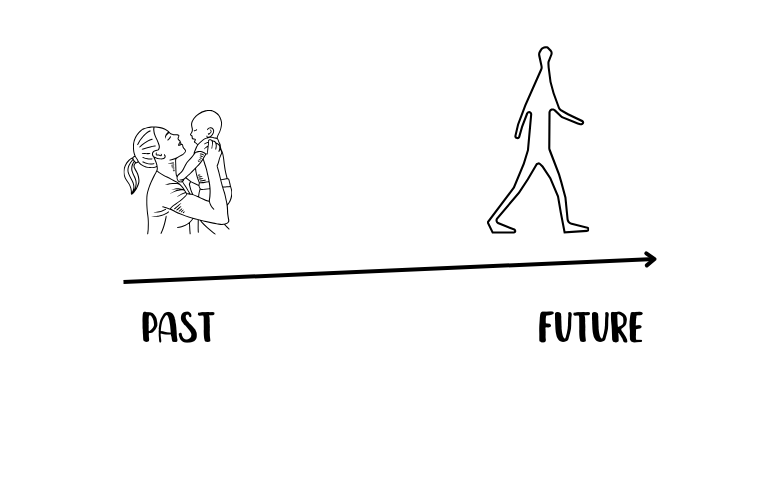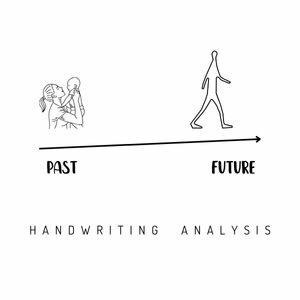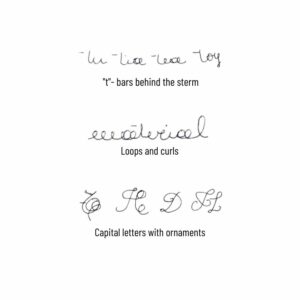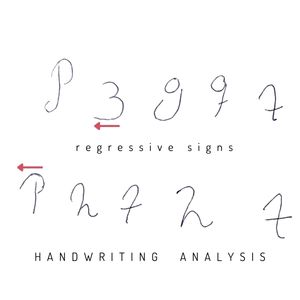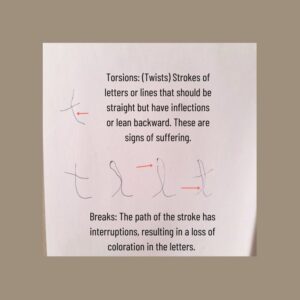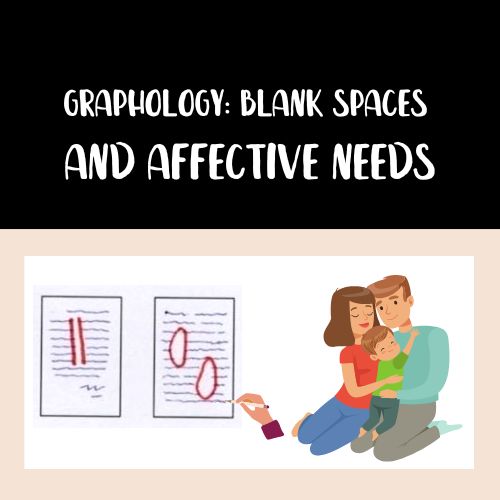On this occasion, I invite you to explore progressive and regressive writing, along with the signs that accompany them. Each one of us, in our existence, in our actions, in our desires, and opinions, manifests a greater interest in others (an extroverted attitude with a centrifugal trajectory) or a centripetal orientation, where self-interest, narcissism, and an introverted attitude predominate. These tendencies are reflected in both everyday life and handwriting.
All writing commonly involves progressive (forward) and regressive (backward) movements. When we write, depending on our personal characteristics, there may be a balance between these progressive and regressive movements, or one of them may prevail over the other.
What Progressive and Regressive Writing Looks Like
Western writing starts from the left edge of the page and progresses towards the right edge. It moves from regression (from the past) towards the future. There are natural strokes in some letters that are drawn from left to right, such as the bars of the letter “t.”
Progressive writing
Progressive writing consists of movements that spontaneously and effortlessly go forward, to the right, and upwards on the paper. These movements contribute to the fluency and ease in writing.
Healthy writing is composed of progressive movements that start in the subject’s present towards the future reality.
Regressive writing
On the other hand, any regressive movement that is not natural to the letter indicates a pause and the individual’s return to their memories, their lived experiences, and their inner reality.
In regressive writing, the movements that form the letters, which should normally advance to the right, return, veering to the left and downward, towards the self. The predominance of letters with a regressive direction indicates the need to take refuge in the past to distance oneself from the current reality, closing off communication to the new and blocking spontaneity.
These movements can be complicated as they disrupt the natural flow of writing.
The degree of progression and regression in writing provides the opportunity to explore:
- How a person relates to the world.
- The ability or difficulty they have in communication.
- The level of determination or indecision in their actions.
Signs of Progressive Writing
Rounded writing, connected writing, right-slanting script, loops, a well-covered right margin, and simple forms are signs that reflect progressive writing.
How to interpret progressive writing Writing
Progressive writing is understood as an expression of the need to establish physical, emotional, and spiritual connections. It indicates an open, spontaneous, frank, and sympathetic attitude. It also reflects a drive to understand issues that affect society at large. In this type of writing, interest in people and external matters tends to outweigh concerns about family or personal issues.
From a negative perspective, it indicates the absence of shyness and susceptibility to influence. When accompanied by narrow, hurried, or extensive writing, it suggests a tendency to avoid or escape from personal problems.
With angular, forceful, disorderly, and clustered writing, it indicates that emotions are not well managed, and the individual may have an explosive character, irritability, violence, and capricious tendencies.
When conducting an initial evaluation of handwriting, the graphologist identifies signs of regression. For example, t’ bars that don’t cross the stem and remain on the left side, a left margin that advances and then returns to the left edge of the paper, strokes or additions to letters after the writing is finished, among others. Each manifestation of regression implies a defense mechanism that obstructs the natural flow and growth, limiting the effectiveness of the individual’s resources.
Excessive presence of regressive movements or gestures in handwriting indicates that the person’s decision-making capacity and ability to advance are hindered or constrained for some reason. Consequently, the individual faces difficulties in fluidly communicating their thoughts and feelings.
Behaviors during Regression
A notable aspect is the emergence of behaviors and attitudes reminiscent of childhood. For example, Freud believed that nail-biting and smoking were indications of being stuck in the oral stage of development. This regression could also manifest in actions related to eating and speech. Staying in the anal stage could lead to a compulsive inclination toward order or disorder, hoarding, and extreme greed. On the other hand, conversion hysteria would be considered a characteristic of regression to the phallic stage.
Now, let’s examine the graphological signs associated with regression. Identifying these specific signs allows us to understand in which areas of the individual’s personality they may be experiencing the greatest difficulties in expressing themselves. These areas include emotions (middle zone), thoughts (upper zone), and willpower (lower zone) to carry out actions.
Indicators of Regression in Handwriting with examples
In the upper zone: The “t”- bars behind the sterm (that do not energetically cross the stem), which can also be in a loop. These are signs of indecision and fear of confronting reality.
Capital letters: Isolated and closed by regressive movements.
Loops and curls: Letters forming excessive loops and curls can be interpreted as an attempt to remain trapped in old thought patterns or behaviors.
Signature on the left: Positioned away from the text and on the left side of the page instead of the right margin indicates isolation with a regressive attitude. Psychological immaturity. When faced with minor issues, the individual reacts with childish behavior. It blocks contact with reality due to insurmountable obstacles. It can also be interpreted as social or professional disinterest.
Ovals with small concentric loops.
Ornaments: Sometimes reflect inferiority complexes compensated for by excessive pride or a desire for recognition.
I’s with i’s with circles (instead of dots) .
Arches in the middle zone: Especially in “m,” “n,” “u,” some capital letters, and t-bars. In the middle zone, the arch is interpreted as a lack of candor, mistrust, and reserve in interactions with the world. In their relations with their surroundings, the individual adopts an artificial and proud attitude, needing admiration. They cling to their ideas and reject everything new.
The upper part of the letters is related to cognitive processes, intellectual functions, thinking, fantasy life, aspirations, and the ability to control impulses and instincts.
Arches or hooks to the left in the upper zone, in a very artificial manner, are interpreted as subjectivity and stubbornness in how they conceive and interpret reality. Ruminating thoughts about oneself, distancing from reality, and seeking refuge in fantasies.
Absence of the left margin or a regressive left margin. If the writing tends to shift towards the left margin of the page, it can be interpreted that the person feels trapped in the past or has difficulty moving forward into the future.
A wide right margin, when combined with other regressive signs, must be carefully considered. This implies a tendency towards social isolation, amplified by the self-enclosure in one’s own thoughts and fantasies.
Fragmentations in the lower zone. The disconnection between the oval and the limb marks a desire to conceal emotions, difficulty in connecting with true desires and needs, hypersensitivity. It is observed in individuals from conflicted families. The individual may immerse themselves in their fantasy life, hindering emotional development and the ability to open up to new environments and people.
Torsions: (Twists) Strokes of letters or lines that should be straight but have inflections or lean backward. These are signs of suffering. Dr. Resten discusses them in “Les écritures patologiques.” It’s important to examine where in the writing they are located, whether in the upper, middle, or lower part. When they appear in the upper part, they indicate that suffering has a mental component related to distressing thoughts. Possible physical issues should also be considered.
When the torsions are found in the lower areas or the limbs are blocked, they indicate the existence of unresolved conflicts and the presence of unconscious fantasies serving as a compensatory mechanism for repressed situations. It’s important to note that the lower part of writing is more associated with repressed impulses and represents the most unconscious dimension.
Breaks: The path of the stroke has interruptions, resulting in a loss of coloration in the letters. It indicates respiratory, circulatory, and nervous disturbances.
Remember that a graphologist does NOT DIAGNOSE.
From a psychological perspective, these indicators refer to obstacles in advancing and growing in life and are linked to unresolved emotional conflicts.
Indicators such as the bars of the “t” on the left side, touches, the left-located signature, and dots on “i” in the form of a circle can be interpreted as signs of indecision, fear of confronting reality, insecurity, shyness, and past conflicts that have influenced the development of self-esteem.
According to A. Vels, “The artist and the neurotic may adopt these childish modes of behavior to escape from reality and the anxiety of frustration.”
Descending, tight, disjointed, restrained, inverted, and suspended writing also relates to regression.
I remind you, as always, that signs are interpreted within a context. Never take an isolated sign.
Blessed be!

